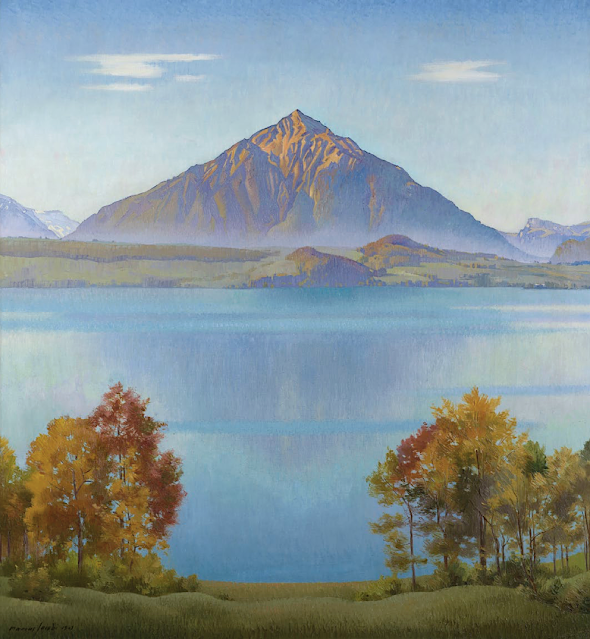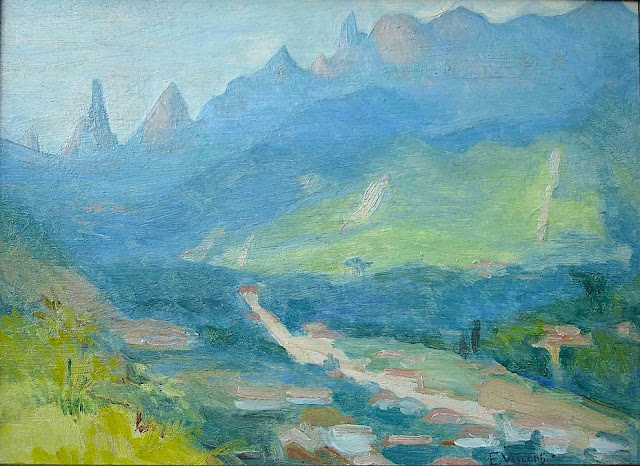NICHOLAS ROERICH (1874-1947)
Belukha Mountain (4,506 m - 14,784 ft)
Russia - Kazakhstan border
In Path to Shambhala, oil on canvas, 1933, Roerich Museum NYC
About Shambala
Nicholas
and Helena Roerich led a 1924–1928 expedition aimed at Shambhala. They
also believed that Belukha Mountain in the Altai Mountains was an
entrance to Shambhala, a common belief of that region. Inspired by
Theosophical lore and several visiting Mongol lamas, Gleb Bokii, the
chief Bolshevik cryptographer and one of the bosses of the Soviet secret
police, along with his writer friend Alexander Barchenko, embarked on a
quest for Shambhala, in an attempt to merge Kalachakra-tantra and ideas
of Communism in the 1920s. Among other things, in a secret laboratory
affiliated with the secret police, Bokii and Barchenko experimented with
Buddhist spiritual techniques to try to find a key for engineering
perfect communist human beings. They contemplated a special expedition
to Inner Asia to retrieve the wisdom of Shambhala – the project fell
through as a result of intrigues within the Soviet intelligence service,
as well as rival efforts of the Soviet Foreign Commissariat that sent
its own expedition to Tibet in 1924. French Buddhist Alexandra
David-Néel associated Shambhala with Balkh in present-day Afghanistan,
also offering the Persian Sham-i-Bala, "elevated candle" as an etymology
of its name. In a similar vein, the Gurdjieffian J. G. Bennett
published speculation that Shambalha was Shams-i-Balkh, a Bactrian sun
temple.
The mountain
Belukha Mountain located
in the Katun Mountains, is the highest peak of the Altai Mountains in
Russia and the highest of the system of the South Siberian Mountains. It
is part of the World Heritage Site entitled Golden Mountains of Altai.
Located in the Altai Republic, Belukha is a three-peaked mountain massif
that rises along the border of Russia and Kazakhstan, just a few dozen
miles north of the point where this border meets with the border of
China. There are several small glaciers on the mountain, including
Belukha Glacier. Of the two peaks, the eastern peak (4,506 m, 14,784
ft.) is higher than the western peak (4,440 m, 14,567 ft.). Belukha was
first climbed in 1914 by the Tronov brothers. Most ascents of the
eastern peak follow the same southern route as that taken in the first
ascent. Though the Altai is lower in elevation than other Asian mountain
groups, it is very remote, and much time and planning are required for
its approach.
In the summer of 2001, a team of scientists traveled to
the remote Belukha Glacier to assess the feasibility of extracting ice
cores at the site. Research was carried out from 2001 to 2003: both
shallow cores and cores to bedrock were extracted and analyzed (Olivier
and others, 2003; Fujita and others, 2004). Based on tritium dating
techniques, the deeper cores may contain as much as 3,000–5,000 years of
climatic and environmental records. A Swiss-Russian team also studied
the glacier.
Since 2008, one is required to apply for a special
border zone permit in order to be allowed into the area (if travelling
independently without using an agency). Foreigners should apply for the
permit to their regional FSB border guard office two months before the
planned date.
The painter Nicholas Roerich known
also as Nikolai Konstantinovich Rerikh (Никола́й Константи́нович
Ре́рих) is quite an important figure of mountain paintings in the early
20th century. He was a Russian painter, writer, archaeologist,
theosophist, perceived by some in Russia as an enlightener, philosopher,
and public figure. In his youth was he was quite influenced by a
movement in Russian society around the occult and was interested in
hypnosis and other spiritual practices. His paintings are said to have
hypnotic expression.
Born in Saint Petersburg, Russia, he lived in
various places around the world until his death in Naggar, Himachal
Pradesh, India. Trained as an artist and a lawyer, his main interests
were literature, philosophy, archaeology, and especially art. After the
February Revolution of 1917 and the end of the czarist regime, Roerich, a
political moderate who valued Russia's cultural heritage more than
ideology and party politics, had an active part in artistic politics.
With Maxim Gorky and Aleksandr Benois, he participated with the
so-called "Gorky Commission" and its successor organization, the Arts
Union (SDI).
After the October Revolution and the acquisition of
power of Lenin's Bolshevik Party, Roerich became increasingly
discouraged about Russia's political future. During early 1918, he,
Helena, and their two sons George and Sviatoslav emigrated to Finland.
After some months in Finland and Scandinavia, the Roerichs relocated to
London, arriving in mid-1919. Later, a successful exhibition resulted in
an invitation from a director at the Art Institute of Chicago, offering
to arrange for Roerich's art to tour the United States. During the
autumn of 1920, the Roerichs traveled to America by sea. The Roerichs
remained in the United States from October 1920 until May 1923.
After leaving New York, the Roerichs – together with their son George
and six friends – began the five-year-long 'Roerich Asian Expedition'
that, in Roerich's own words: "started from Sikkim through Punjab,
Kashmir, Ladakh, the Karakoram Mountains, Khotan, Kashgar, Qara Shar,
Urumchi, Irtysh, the Altai Mountains, the Oyrot region of Mongolia, the
Central Gobi, Kansu, Tsaidam, and Tibet" with a detour through Siberia
to Moscow in 1926.
In 1929 Nicholas Roerich was nominated for the
Nobel Peace Prize by the University of Paris. He received two more
nominations in 1932 and 1935. His concern for peace resulted in his
creation of the Pax Cultura, the "Red Cross" of art and culture. His
work for this cause also resulted in the United States and the twenty
other nations of the Pan-American Union signing the Roerich Pact on
April 15, 1935 at the White House. The Roerich Pact is an early
international instrument protecting cultural property.
In 1934–1935,
the U.S. Department of Agriculture (then headed by Roerich admirer
Henry A. Wallace) sponsored an expedition by Roerich and USDA scientists
H. G. MacMillan and James F. Stephens to Inner Mongolia, Manchuria, and
China.
Roerich was in India during the Second World War, where he
painted Russian epic heroic and saintly themes, including: Alexander
Nevsky, The Fight of Mstislav...
In 1942, Roerich received
Jawaharlal Nehru at his house in Kullu. Together they discussed the fate
of the new world: "We spoke about Indian-Russian cultural association,
it is time to think about useful and creative cooperation ...”.
Gandhi would later recall about several days spent together with
Roerich's family: "That was a memorable visit to a surprising and gifted
family where each member was a remarkable figure in himself, with a
well-defined range of interests." ..."Roerich himself stays in my
memory. He was a man with extensive knowledge and enormous experience, a
man with a big heart, deeply influenced by all that he observed".
During the visit, "ideas and thoughts about closer cooperation between
India and USSR were expressed. Now, after India wins independence, they
have got its own real implementation[clarification needed]. And as you
know, there are friendly and mutually-understanding relationships today
between both our countries".
In 1942, the American-Russian cultural Association (ARCA) was created in New York.
Its active participants were Ernest Hemingway, Rockwell Kent, Charlie
Chaplin, Emil Cooper, Serge Koussevitzky, and Valeriy Ivanovich
Tereshchenko. The Association's activity was welcomed by scientists like
Robert Millikan and Arthur Compton.
Roerich died on December 13, 1947.
Presently, the Nicholas Roerich Museum in New York City is a major
institution for Roerich's artistic work. Numerous Roerich societies
continue to promote his theosophical teachings worldwide. His paintings
can be seen in several museums including the Roerich Department of the
State Museum of Oriental Arts in Moscow; the Roerich Museum at the
International Centre of the Roerichs in Moscow; the Russian State Museum
in Saint Petersburg, Russia; a collection in the Tretyakov Gallery in
Moscow; a collection in the Art Museum in Novosibirsk, Russia; an
important collection in the National Gallery for Foreign Art in Sofia,
Bulgaria; a collection in the Art Museum in Nizhny Novgorod Russia;
National Museum of Serbia ; the Roerich Hall Estate in Nagar village in
Kullu Valley, India; the Sree Chitra Art Gallery, Thiruvananthapuram,
India;[17] in various art museums in India; and a selection featuring
several of his larger works in The Latvian National Museum of Art.
_______________________________
2022 - Wandering Vertexes...
by Francis Rousseau


















